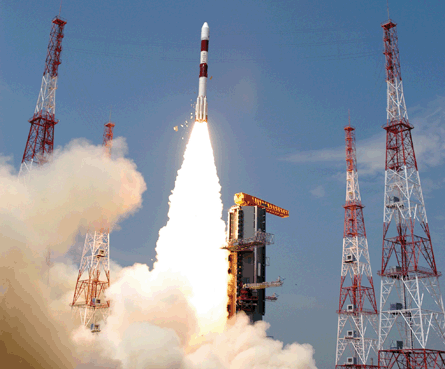The Indian Space Research Organisation hopes to put itself back on a winning trajectory with its first launch since the spectacular failure of its first two attempts to fly its GSLV rocket in April and December 2010.
Scheduled for the first quarter of this year, the launch, from Satish Dhawan Space Centre on Sriharikota island, off India's eastern coast, will see ISRO's workhorse Polar Satellite Launch Vehicle (PSLV) carry a three-satellite payload.
Featuring four alternate liquid- and solid-fuel stages, the PSLV is ISRO's first operational launch vehicle and has a sound track record of carrying out multiple launches. Weighing 295t at launch and standing 44.9m (147ft) tall in standard configuration, the PSLV can launch either a 1,600kg (3,500lb) satellite into a Sun-synchronous/polar orbit or a 1,050kg satellite into a geostationary transfer orbit.
 |
|---|
© ISRO |
The PSLV's first stage is one of the largest solid-propellant boosters in the world, carrying 139t of fuel. A cluster of six strap-ons are attached to the first-stage motor; four of these are ignited on the ground and two are air-lit.
ISRO describes the PSLV as reliable and versatile, having achieved a run of 16 successful flights through to its last mission in July 2010. Payloads have been orbited on commercial terms for clients in Algeria, Belgium, Canada, Germany, Indonesia, Israel, Italy, South Korea and Switzerland.
Although the PSLV was developed as a workhorse for launching India's 1t class Earth observation satellites in polar/Sun-synchronous orbit, it has evolved into a versatile launcher capable of delivering payloads into near-Earth, middle-Earth and geostationary transfer orbits.
The larger, 49m-tall, 414t GSLV was designed to give India self-reliant capability to launch its Insat series of domestic communications satellites, which weigh 2,000-2,500kg. Most of the Insat satellites now in operation have been launched by the European Space Agency's Ariane 5 rockets.
The GSLV, and particularly a home-grown cryogenic engine for it, also holds the key to the ISRO's high-profile mission plans, including the 2013 launch of the Chandrayaan-II Moon mission and a human flight mission planned for 2016.
The failed 15 April GSLV mission was propelled by a home-grown cryogenic engine stage, carrying 12.5t of liquid oxygen and hydrogen. The rocket that failed on 25 December featured a Russian cryogenic engine.
ISRO began developing an indigenous cryogenic engine in the early 1990s, but has still not been able to qualify the home-grown cryo stage. Since then, it has used six out of seven cryogenic engine stages supplied by Russia under an agreement made after the USA prevented Russia from transferring cryogenic engine technology to ISRO in 1992.
ISRO is also developing a Mark III version of the GSLV that will be capable of placing a 4t-class satellite into a geostationary transfer orbit. The three-stage, 629t heavy GSLV-MKIII calls for a cryogenic upper stage with a 25t loading of liquid hydrogen and liquid oxygen.
The forthcoming PSLV launch is planned to orbit India's advanced remote sensing satellite Resourcesat-II, envisaged as a follow-on to Resourcesat-1, which was launched in 2003. As piggyback payloads, the rocket will carry Singapore's Nanyang Technological University's 100kg X-sat micro satellite and Youthsat, an Indo-Russian micro satellite carrying payloads designed by university students.
A second PSLV launch is due in the second quarter, to put India's 1,375kg GSat-12 communications satellite into a geostationary transfer orbit. It will replace Insat-3B, which was launched in March 2000.
Source: Flight International


























